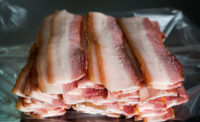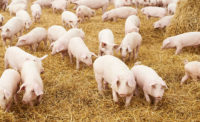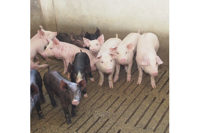State of the Industry: Pork
Not out of the woods yet

According to FreshLook Marketing, for the 52 weeks ending July 22, 2012, fresh pork sales decreased 0.3 percent in dollar sales and 5.4 percent in volume compared to the same period a year ago. The average price of pork increased 5.4 percent during this time period.
In the coming months, hog supplies are expected to remain fairly steady. Retailers are encouraged to continue featuring pork this fall and into winter, offering consumers savings at the meat case, especially in the face of higher prices across the meat case.
To help retailers and packer/processors boost their pork sales, the National Pork Board focused on several key initiatives in 2012, including working with retailers on various promotions and educating consumers to cook pork to 145°F. These programs are just the start to helping the industry meet some challenging objectives by 2014. These objectives include a 10 percent increase in real per capita domestic consumer expenditures for pork (as compared to 2009), a 10 percent increase in annual eatings per capita of fresh pork as measured by the NPD Group’s National Eating Trends data versus 2009, and an increase in consumers’ awareness of how to cook pork in a way that results in a juicy, tender and flavorful eating experience, as measured by a 10 percent improvement in a national market survey.
In the next year, the largest obstacle for the pork industry will be higher input costs. In the face of this issue, the U.S. inventory of hogs has held steady rather than grow, as producers have been hesitant to increase their herd size because of these high prices, primarily centered on feed ingredient costs. Add to that strong export demand, and the perfect storm has been created for higher pork prices at retail.
As a result of higher prices for almost all food categories, consumers have become more price sensitive than ever before, and have grown more value-focused. Price per pound and total package price continue to be drivers. The National Pork Board encourages retailers to feature pork frequently and consistently to provide value to their customers and help them save at the meat case.
Consumers are also looking at other attributes beyond price, including package size, convenience, versatility of the cut and how well it meets their recipe needs. Retailers must make sure they have adequate in-store education for consumers on the various cuts of fresh pork and how to prepare them. This is even more critical now than before, as prices increase and consumers may be hesitant to purchase an unfamiliar cut of pork through which they might risk having a less-than-satisfactory meal at home.
Retailers and suppliers must also offer variety in their pork selection and then work to educate consumers on new cuts and cooking methods to ensure they have a great eating experience at home. Often, consumers do not understand all of the different cuts available to them, and end up purchasing the same staple cuts every time they shop the meat case. Without education, consumers don’t know the great options they have at the meat case and only purchase cuts that are most familiar to them. This can limit sales of featured items as well as limiting possible up-sell opportunities.
We also know that consumers start the grocery-shopping process at home, and do more pre-planning before they go to the store. Consumers have more information about products available to them than ever before, and will do more research on products and recipes prior to their supermarket trip. Retailers have an opportunity to gain customer loyalty by making it easier for shoppers to get product information through mobile apps, Quick Response (QR) codes, and online via Web sites and social media. Adding pork recipes to a Web site or sharing pork preparation tips through social-media channels is a great way to increase conversation with consumers, build relationships and increase long term loyalty.
The magic number for cooking pork is still 145°F. Since the USDA reduced the final cooking temperature for pork to 145°F, with a three-minute rest time, home cooks can now enjoy medium-rare pork that is juicier and more tender than when cooked to the more traditional 160°F. This temperature drop is pivotal for the pork industry, which has worked for years to promote this change.
The success of the 145°F effort depends on educating consumers that pork, cooked to 145°F, is recommended. The National Pork Board encourages retailers to spread the word to their consumers so that they have a great eating experience and keep coming back for fresh pork.
Today’s consumers look at pork differently than other proteins and choose pork because of its delicious flavor and versatility. Combined with its attractive price point, it is the ideal protein to purchase for a variety of family-friendly meals.
Retailers can capitalize on pork’s favorable position by purposefully thinking about pork when developing planograms and ads. Educating consumers with in-store information on the various cuts of fresh pork and how to prepare them, and providing them with different recipe ideas can help create an easy and efficient shopping experience for consumers, and ultimately increase sales for the meat department.
Looking for a reprint of this article?
From high-res PDFs to custom plaques, order your copy today!






